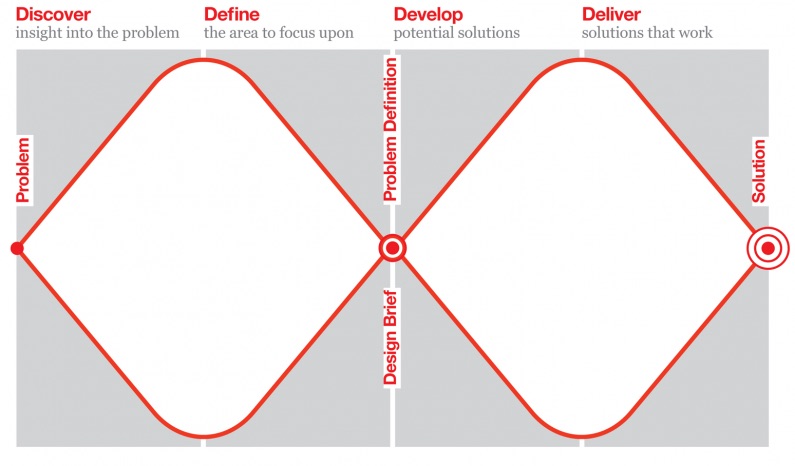


It’s highly likely you’ve watched a TED talk, sat through a powerpoint presentation, read Harvard Business Review or attended a workshop that contained buzzwords like empathy, collaboration, human-centred design, ideation, design thinking or service design.
It’s easy to feel perplexed – are these methods, processes, mindsets, approaches or frameworks? In essence, these words are often used to describe activities: conducting user research to understand human needs, defining problems that needs solving, coming up with ideas, or putting users at the user at the heart of a product or service design.
In this article I will be looking to clarify two of the most overused and under-defined buzzwords: Design Thinking and service design.
Firstly, before I dig deeper into those topics… I want to look at a word, contained in both: ‘design’. In the English language, the word is both a verb and a noun. Designing means thinking, processing and applying intent (verb). But it can also be the final result – the outcome, the artefact (noun).
Design, in its simplest form, is about rendering intent. When a person makes a choice about how they want something to be, they are designing. If we intend to create great designs, how will we render that intention? That’s the role of a design process.In our research, the teams that produce the best designs, have a process that’s geared towards forming a common understanding.- Jared Spool
In both the Design Thinking process and service design, we use the verb to define and create the noun. So what are the main differences between the two terms?
Design Thinking is a codified process
Design Thinking is a process, geared towards gaining a common understanding. One of the first people to use the term was Peter Rowe in his book, Design Thinking, published in 1987. ‘Design Thinking’ may have been coined in the 1980s, however its roots have grown during the last century from scientific research, the social sciences and a rich history of design and innovation.
The Wright brothers, for example, built their first successful airplane after spending years prototyping and iterating on their designs. They embraced learning from failure as a route to success. Thomas Edison gained insight through the direct observation of people. He collaborated with other gifted innovators to develop the lightbulb (and a number of other products), through an iterative process of trial and error. More recently, in 1983 James Dyson invented the bagless vacuum cleaner. He spent the last five years building and testing 5,127 prototypes. This spirit of relentless invention and (let’s face it) a love of solving vacuuming pain points, still shapes his multinational business today. James Dyson advocates that all the engineers and scientists build and test their own prototypes to gain a deeper understanding of what works and what doesn’t.
There are many flavours of Design Thinking. IDEO, IBM, d.School and the British Design Council all have versions of it. A google search brings up a plethora of diagrams outlining the desired steps.

Designers from many disciplines, like architecture, advertising and industrial design, would recognise a lot of the activities and methods used in Design Thinking. Design Thinking is the codifying of these practises and methods into a series of steps, an articulated design process. It is a recipe to follow that imposes some order onto the messy, often, subjective business of designing. In other words, Design Thinking can be thought as thinking and doing like a designer – i.e. designing! We are back to verbs again.
Design Thinking can be described as a discipline that uses the designer’s sensibility and methods to match people’s needs with what is technologically feasible and what a viable business strategy can convert into customer value and market opportunity. - Tim Brown
Designers against Design Thinking
For many, shoe-horning a designer’s sensibility and methods into a series of steps over simplifies what a designer does and restricts the capabilities of a designer. Designers, such as Natasha Jen, a partner at design firm Pentagram are voicing their disquiet against Design Thinking movement. Natasha’s concern is that Design Thinking is being touted as a process that anyone can use and it can be applied to any problem. There is little guidance within the Design Thinking process on how to hold a mirror up to the ideas, to interrogate them within the context of a complex world and to dig deeper to get to more meaningful solutions. At the most, critiquing the ideas has been reduced down to voting with sticky dots with little framing to why certain ideas ‘win’.
The rigour, credibility and critical thinking that designers have developed throughout their careers and had instilled in them from their art school educations can feel absent from the Design Thinking process. I have an art school education and learning to critique and feedback on one another’s work was fundamental to becoming a good designer and developing sound solutions. You learned how to scrutinise one another’s designs and rationales and how to iterate ideas beyond the obvious. In Design Thinking, the feedback loop relies heavily on the users without much internal scrutiny from stakeholders or team members prior to testing. From my own experience (working within agencies as well as on the client side), it’s easier to get fellow designers together to critique work than it is to find time with stakeholders to commit to regular design reviews.

In my opinion, both the strength and weakness of Design Thinking is its reliance on multidisciplinary teams. It’s great to break down silos and get different areas of the business working together on projects. In workshops, I’ve regularly witnessed the passion and energy of these multi-disciplinary teams – and yes, ideas do emerge that designers alone couldn’t have shaped without the wider input.
The downside to this method is one of practicality. It is often difficult to find ongoing quality time with the multidisciplinary teams to push the ideas further and continuously evaluate them before testing with the user. Integrating critique into the Design Thinking process would help to identify problems with the prototype and get more business input before testing. But just because Design Thinking doesn’t have a clear, defined step for critiques doesn’t mean you can’t carve out time to conduct them. Often, the biggest challenge isn’t what to do with the critique feedback, but simply to get people to clear their diaries.

But for all its hype, Design Thinking has at least provoked an interesting debate within the design community given and non-designers a steer on how to address business problems from the outside in. The IDEO, IBM, d.school and British Design Council’s brands of Design Thinking have made their way into the business world and the methods are now being used to help solve business problems. Through Design Thinking, designers and other non C-suite members now rub shoulders with C-suite members and are helping to influence business strategy decisions and shape innovative ideas. Traditionally, designers had been engaged much later in the development of a product or an idea, and Design Thinking has helped them move upstream. Some designers now feel that they have earned a seat at the business leadership table and have moved away from applying the polish to someone else’s idea. The currency of the designer has been elevated.
Service design is the conscious design of services
Service design, on the other hand, is the design of systems that encompass service users, service providers, processes and logistics. Service design uses some of the same methods, tools and activities of Design Thinking to help make services more useful, usable, efficient and desirable.
When Thomas Edison invented the lightbulb, he was actually thinking about his product in context of its ecosystem – he was designing the service around it. Even though he is famous for inventing the lightbulb, this product revolutionised our lives only because he paired it with the invention of the Edison Electric Illuminating Company, which built stations to generate the electricity that would power those products. His service, the provision of energy, unfolded over many years, with some parts visible to the user (the lightbulb) and some parts hidden to the user (the electrical generating stations).
Every product is a service waiting to happen. - Malin Maki
Most product companies are actually service companies. Services are delivered to users via a digital or non digital channel, and when users interact with the service, this is known as a touchpoint. Modern services happen across a number of channels and touchpoints. The duration of time the user interacts with the service is known as a journey, and it might span minutes, hours or years.
Service Design often involves the creation of maps that demonstrate the experience of the service and its moving parts. These maps come in many varieties: business model diagrams, customer journey maps, service blueprints are some examples. From what users see and feel, to the logistics involved to make the service happen, mapping for service design allows designers to visualise insight and understand issues and opportunities. These maps are often created using Design Thinking methods, including customer research and collaborative client workshops. Service design maps are not static artefacts – they can (and should) be built on and developed as more customer and business insights are revealed, over time.
[Service design is] a method for designing experiences that reach people through many different touch-points, and that happen over time. - Servicedesign.org
After mapping, prototyping (another method used in Design Thinking) can then help to play out the future improvements to the service. Cardboard models, LEGO® or improvisation are some of the ways that new ideas can be explored and provide insights.
.jpg)
In conclusion, Design Thinking is a design process, a recipe you can follow or adapt to define and solve problems. Service design often uses this methodology to solve problems beyond product and digital experiences.
Service users, customers or the staff involved in using your product or service won’t care whether you followed a Design Thinking process. They care about the outcomes that Design Thinking achieves. The creation of meaningful services and products that enhance their lives and addresses their needs.





Ben is on hand to answer your questions.


.jpg)

.jpg)
.png)



.svg)




.png)

